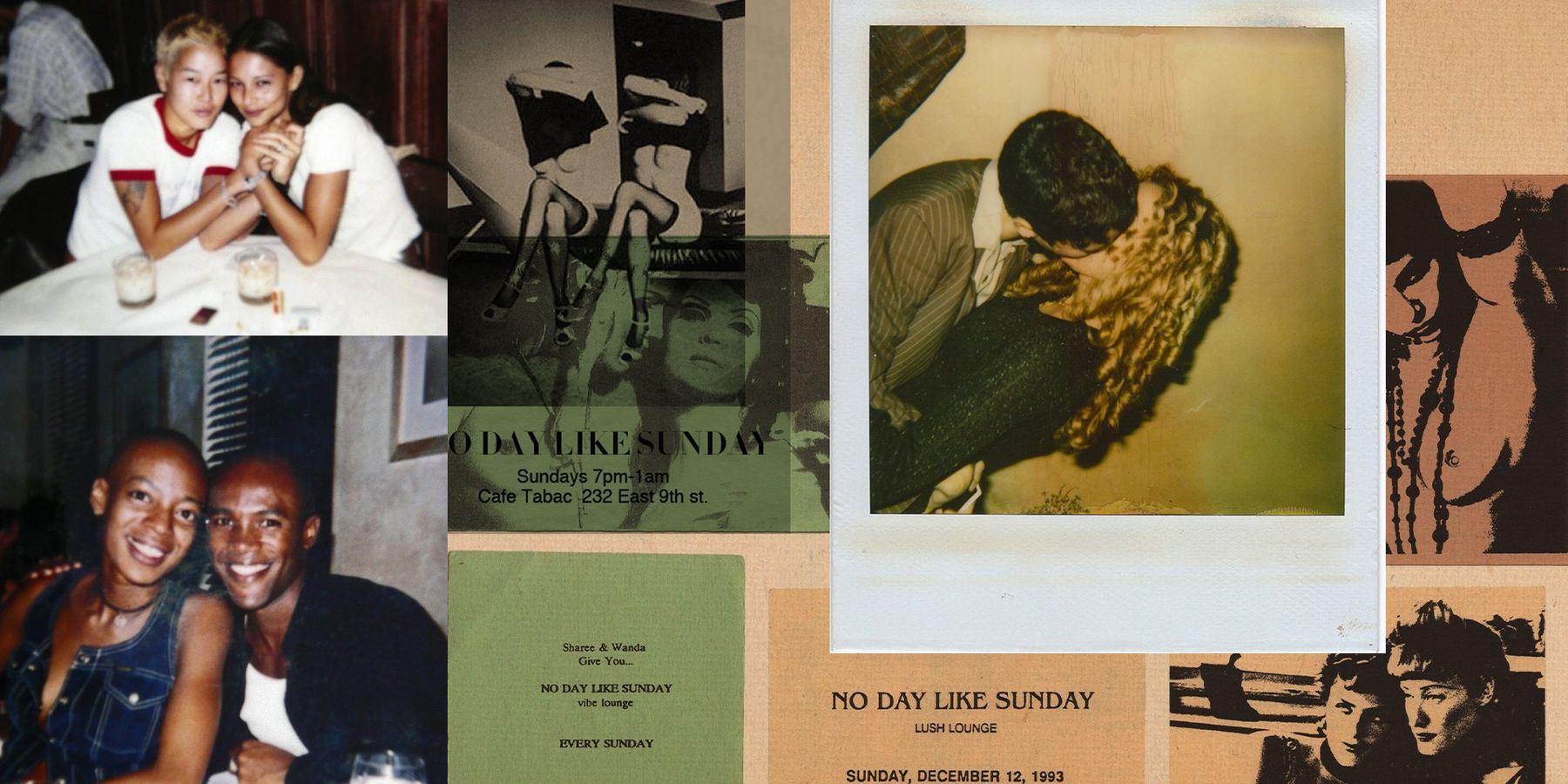
On any given Sunday in 1993, fresh from releasing her explosive "SEX" tome and the equally explicit album "Erotica," Madonna could be found at the chicest lesbian party at the hottest of restaurant-bars in the East Village. Flanked by gay it-girls like CK One model Jenny Shimizu or OG nepo baby socialite Ingrid Caseras, the pop star, in her prime, would ascend the winding stairs to the VIPs-only second floor and walk the runway between tables full of New York City's most beautiful women, who wouldn’t even pretend to hide their stares. Any given Sunday, Queen Latifah might be in the adjoining room, playing a round on the pink felt pool table and buying drinks for all the players, part-time model-DJ Sharee Nash playing a sensual mix of imported Euro acid-jazz and neo-soul; women buy cassettes to take home with them at the end of the night.
A salon that ran from 1993 to 1995 at the model-owned celebrity hot spot, Café Tabac’s "No Day Like Sunday" — known colloquially as "Sundays at Café Tabac" — has been credited with being the birthplace of “lesbian chic.” A cultural moment christened by the media, lesbians' 15 minutes had to do with a convergence of social and political elements, but perhaps no physical space embodied it more than Sharee Nash and Wanda Acosta's famed fashion-forward party in the East Village. Owned by a male model with regulars like Naomi Campbell, Bono and Fran Lebowitz, Café Tabac was already a chic place to see and be seen for the fashion set, but Sundays were for the girls like designers and stylists (and ex-girlfriends) like Patricia Field and Rebecca Weinberg and rapper MC Lyte. A 1994 New Yorker profile of indie filmmakers Guinevere Turner and Rose Troche (also ex-girlfriends) fresh off their Sundance Jury win for their dyke film Go Fish were profiled "drinking Scotch and smoking Rothmans" one Sunday at Tabac, wherein Troche says, "you don't have to look straight or act straight." A New York Magazine item praised Tabac's crowd for being glamorous and "ethnically and sartorially diverse."
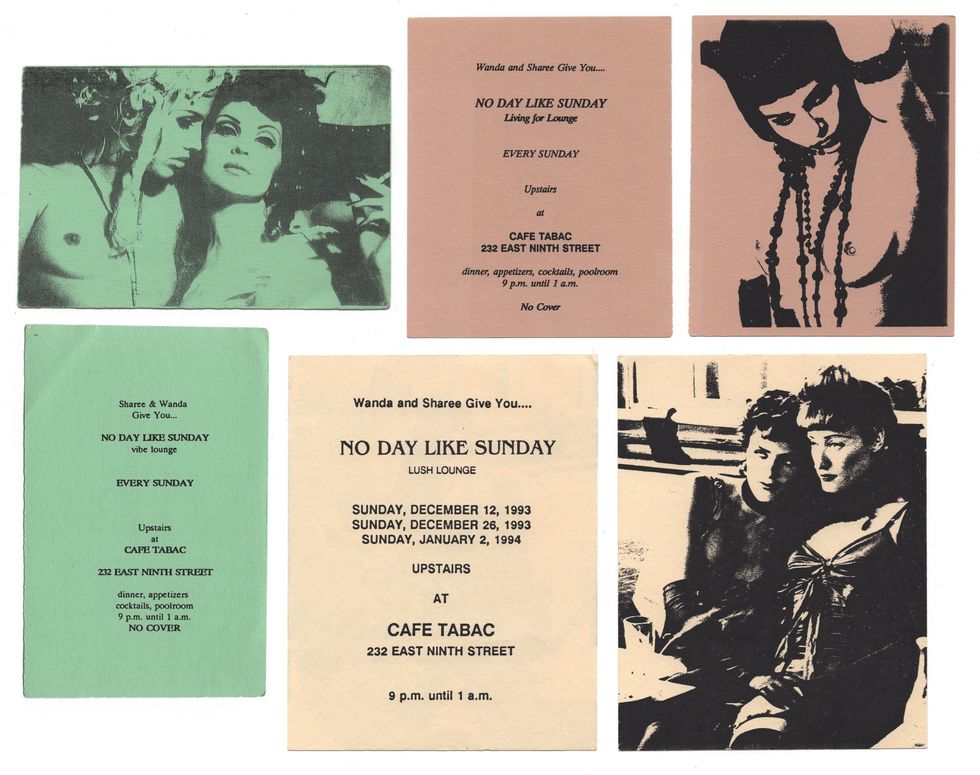
The party was intended to be something private but different from the dyke dive bars Acosta had been accustomed to. At 28, the Nuyorican party girl divorced her husband and wanted to meet women but was struggling to find a place where she felt comfortable.
"I was already feeling like I had been hiding this part of myself for so long," Acosta tells PAPER, "so to have to go down to this dark basement in the back of some space to meet women felt really claustrophobic. I wanted to see a place that was a more elevated, visible [space] that I could explore, getting dressed up and going out and seeing beautiful women."
Acosta happened upon Nash at Alexander Smalls' hip Village soul food restaurant where models worked as hosts, among them some of Nash's girlfriends. One night in '93, Nash (a writer herself) sat reading Virginia Woolf's Orlando.
"I guess that was her cue to think 'Maybe she's gay,'" Nash says. The two struck up a conversation and found themselves discussing lesbian nightlife, craving something "different."
"Just for diversity — different energy, different music, different food, different looks and different people," Nash says. Having recently moved back to New York from Germany, Nash was DJing small spots and was tired of big clubs. There were some great options like The Clit Club at Bar Room 432 on Fridays, but New York was shifting into a dinner-and-drinks era where patrons would commandeer an event all night and let the party circulate around them. The idea of dinner was appealing for Nash, who says that, growing up in St. Louis, her family was big on Sunday meals. She describes the ideal Tabac night as dinner followed by "cocktails, running around, dancing, dessert, then dessert."
The party started out as private – word-of-mouth and invite-only — which was part of the appeal. Some of the potentially closeted attendees appreciated the clandestine affair; rarely were photos taken in the pre-cell phone era.
"We didn't invite the celebrities," Nash says. "They just found out and they just started showing up."
With New York fashion and celebrity comes New York media, and the party started to pick up bits in the press, including the aforementioned New Yorker piece. Designer friends would create looks for Nash to wear as she worked the party, enabling her to connect adoring fans to the creator in the very same room.
The salon only ran for two years, but the stories and symbolism of No Day Like Sundays has been so enduring that co-creator Wanda and filmmaker Karen B. Song have been working on a film documenting the women and time of Tabac, touching on what made it so special.
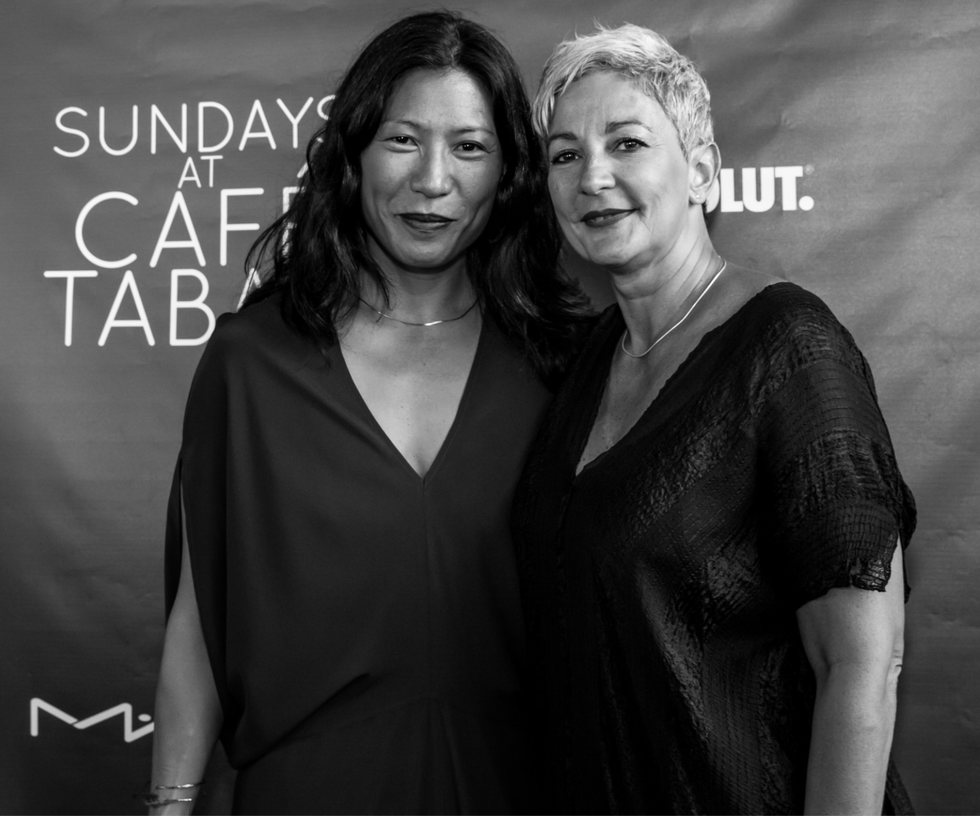
"There was that performative aspect of it," Song says. "You would walk in that space and see what it was like to see the confidence in front of you, what that translates to."
Acosta says Sundays at Tabac "allowed women to be able to come in and express themselves in a different way than they had been able to before."
"I think before we were dressing and signifying each other through our dress codes," Acosta says. "In the early '90s, we started to be able to express ourselves as individuals."
Several of the aforementioned women like Patricia Field, Jenny Shimizu and Guinevere Turner are interviewed for the Sundays at Café Tabac documentary, as well as other attendees such as award-winning author Jacqueline Woodson, gay critics Michael Musto and Hilton Als and butch icon Lea DeLaria, all reflecting on the weekly gathering set amongst a highly visible moment for lesbians and, more generally, queer women."We all loved just watching to see who was gonna come up the stairs — what they were wearing and who they were with, " Acosta says. "It was really a bit of voyeurism as well."
Voyeurism looms large in lesbian chic, as lesbian visibility has always been a Xena-sized double-edged sword. Although lesbian chic has certainly achieved more visibility and acceptance for some lesbians, lesbians themselves weren't always in charge of the messaging. "Lesbian chic" was a tangible trend co-opted by the media looking for a sexy new flavor of the month, and, post-AIDS, gay women were finally on the menu.
Madonna, for one, thrust sexual experimentation into the zeitgeist in the late '80s, first with a flirtatious and rumored relationship with Sandra Bernhard in tabloids and then late-night television. Together, they appeared on "The Late Show with David Letterman" in matching ACT Up uniforms (white T-shirts, denim jean shorts and Doc Martens), dropping New York lesbian dive The Cubbyhole into salacious conversation.
"She was an enfant terrible sometimes, but for the most part, I think everyone was like, 'Whoa – what's, what is she gonna do next?'" Song says of Madonna. "She was so at the prime – she was in the media eye and every time she was photographed or at a party or at a fashion show or whatever, shooting a music video, she always had a lesbian with her."
After falling out with Bernhard (reportedly over Caseras), Madonna set her sights on k.d. lang, feigning a romantic or sexual relationship with the androgynous country-punk crooner and likening her handsome swagger to both her ex-husband Sean Penn and Elvis. (Later, lang would admit they shared a publicist and that the lesbian chic thing "probably benefitted" the both of them.)
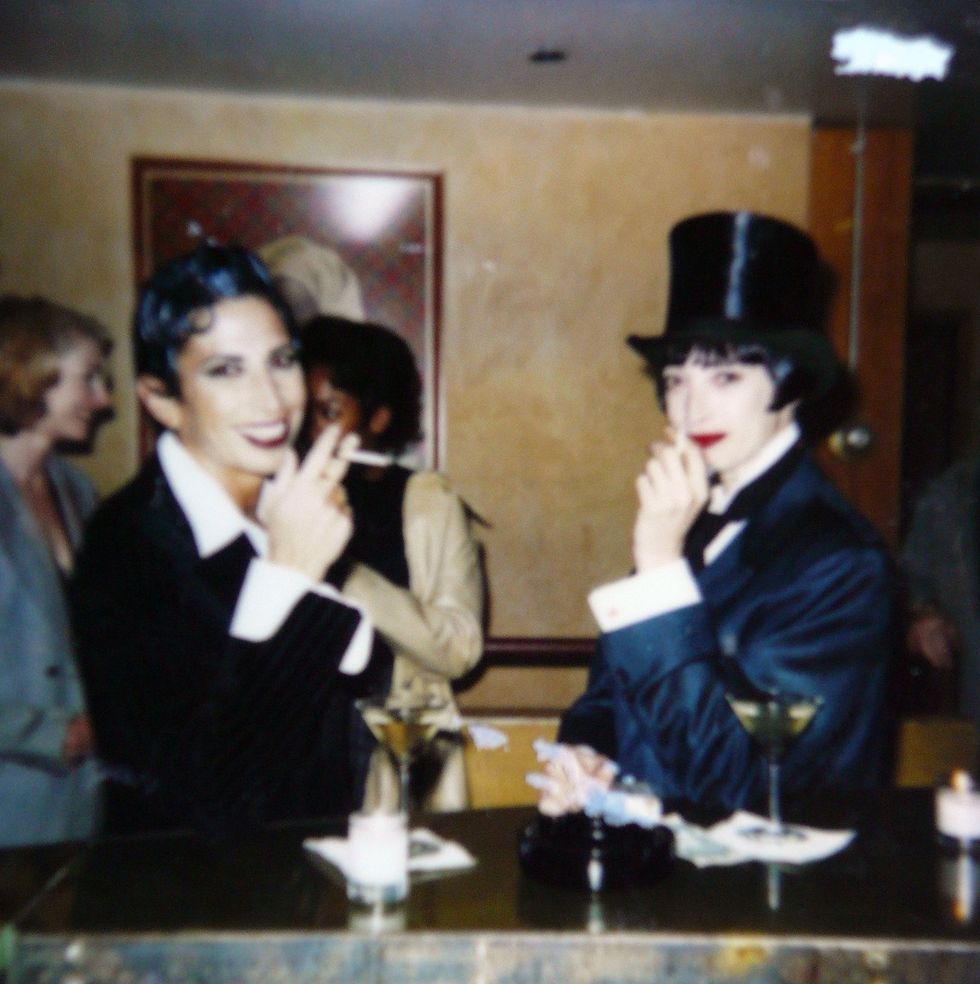
More than Madonna, lang played an integral role in the visibility of lesbians because, for one, she is one. lang's coming out on the cover of The Advocate in May 1992 followed the success of her sex bomb of a pop crossover album Ingenue, a Grammy-winning turn that was due, in part, to her hit devouring single "Constant Craving."
Both the pop cultural and political landscapes were primed for lang to confirm that the seductive love songs on Ingenue were written about women, and she seemed to be rewarded for her outsiderness as opposed to being shunned by it, as she had in the country music realm. She was tired of staying in the closet and playing by as many rules as she could abide, and so her move into contemporary pop came with self-acceptance, a laissez-faire attitude and confident seduction in suits on stage and in interviews. Lang stirred something in people of all genders and sexual orientations. People were fascinated by her, unclear where or how to place her in their desires, but, well, craving more. Lang's effect was so palpable that she won a 1993 MTV Video Music Award for Best Female Pop Performance despite, as she remarked, "never getting played on MTV."
Lang's coming out happened in the Clinton era, when the President and First Lady counted a few well-placed lesbians as friends and third-wave feminists were turning political actions into protests for lesbian visibility. The singer rode along the pop cultural push for lesbians to be recognized and represented and became a de facto poster girl. A now-famous New York Magazine cover from 1993 has the square-jawed singer gazing into the lens, brow angled in a saucy dare; all capital letters, all-white font: "LESBIAN CHIC" emblazoned across her velvet-clad cross-body arm, the subhead "The Bold Brave New World of Gay Women" literally resting on her shoulder.
It wasn't just k.d., of course. In 1993, Melissa Etheridge came out and released her Grammy-winning Yes I Am, Lea DeLaria made dyke jokes on The Arsenio Hall Show and, by then, openly queer Sandra Bernhard had both a Playboy cover and a regular bisexual role on Roseanne. Tennis star Martina Navratilova had her dyke drama splashed all over The Washington Post. It was primarily white women being celebrated for their chicness, and that there were at least a handful of them being so visible meant only one thing to the media — lesbianism was a cool new trend that could be exploited for a hot minute.
In August of '93, lang was being shaven and straddled by supermodel Cindy Crawford on the cover and in the pages of what is now an iconic issue of Vanity Fair.
“I don’t know how to use femininity as a powerful tool. I use my sexuality, but I eliminate the gender from it," lang told Vanity Fair, saying that she's long felt a "social pressure to be beautiful, thin, stylish."
Never before had a butch lesbian been celebrated, despite a long lineage, and while her Vanity Fair issue remains one of the most iconic covers ever, it wasn't long before butches were erased from the lesbian chic narrative in favor of something more desirable by men.

At least the Vanity Fair piece was all about lang; the New York piece mentioned her briefly but primarily reported on the trend of openly gay women who have "transformed the lesbian image." Author Jeanie Russell Kasindorf reported that "the short-haired 'bulldyke' is still many Americans' idea of what a gay woman looks like. Now 'lipstick lesbians' and 'designer dykes' share the bar with the 'butch/femme' group; the downtown black leather crowd and women in Jones New York suits wander among them.'" In other words, anyone could be a lesbian, which made lesbians both visible and invisible at the same time.
This new attention spawned skewed speculation from places like Playboy ("the secret to the craze is that Nineties-style lesbianism requires no commitment"), 20/20 and Geraldo Rivera; coffee table how-to guides on lesbian hair, dress and sex (primarily addressing a straight, curious audience) and fashion editorials posing glamorous women together in suggestive photos ripe with Sapphic subtext. It seemed there was a proliferation of lesbians out of nowhere — lesbian comedian Kate Clinton joked in a 1993 LA Times piece that lesbian chic is "in a lot of ways what lesbian separatism was, but with better PR."
For women like Clinton who had been performing publicly out as a lesbian since the early ‘80s, the new fad of “lipstick lesbians” and “designer dykes” was alienating to the larger community. Some found it hypersexualizing while others found it neutering, forcing a recycled conversation about respectability politics and feminist principles that has and will continue to plague lesbians for as long as we live in a hetero-patriarchal, capitalist society. If we don't own our own narratives, then how can any of us know or agree upon what a lesbian is or should be?
Mairead Sullivan, Associate Professor of Women's and Gender Studies at Loyola Marymount University and author of Lesbian Death, says 1993 was significant in that it "was the year 'lesbian' lost its political bite," at least to the consuming public.
"This is a moment when 'lesbian' is no longer politically associated with a militant radical feminism," Sullivan tells PAPER. "Lesbian chic arrives as a disidentification of feminism."The early '90s was removed enough from the '70s that lesbians were no longer associated with the militant radical feminism of their foremothers, instead acting in response to it. No longer operating out of separatism, women came to work with gay men and trans people during the AIDS epidemic, a new generation of lesbians and bisexual women developing and honing demonstration tactics, bringing newfound ways of being seen and heard into a new future of sex positivity.
Media spectacle was one way to get attention. Sullivan points to the political work and televising of the 1993 March on Washington (where the action group the Lesbian Avengers held the first-ever Dyke March with 20,000 lesbians marching together) as part of what led heteronormative stalwarts like Newsweek to run cover stories on lesbians and "the limits of tolerance."
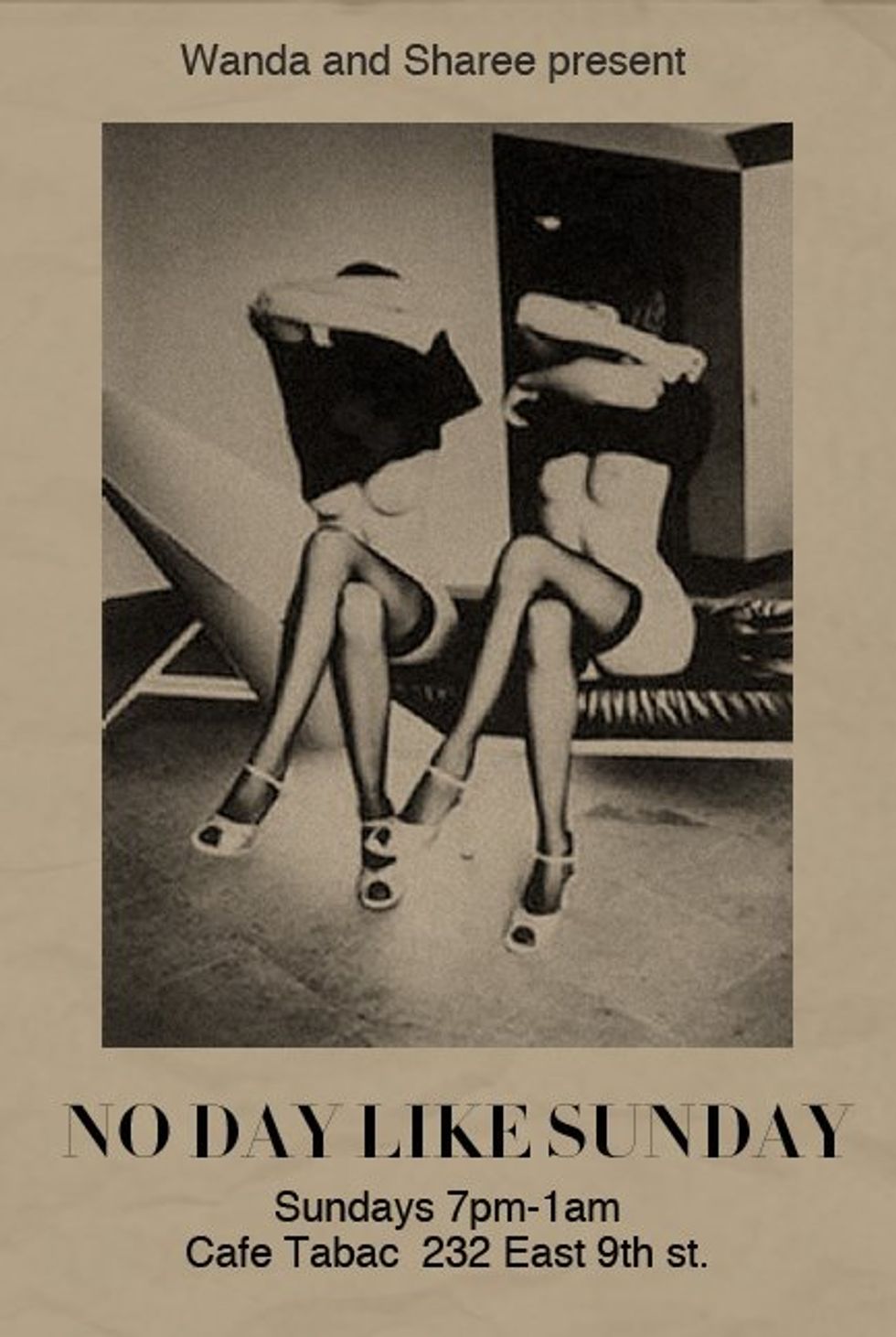
"Some people are panicking about [lesbians] and the Newsweek article is doing this identification of it: 'Lesbians are all good trying to raise children, not fringe topless lesbians with their fists in the air,'" Sullivan says. No longer were lesbians seen as men-hating threats to the nuclear family if all they wanted was to be part of their own.
The irony is that lesbian visibility could not have happened without the topless lesbians or their fists. It was these activists who forced the lavender menace conversation with NOW, seeking to be part of resourced feminism post-women's liberation, and in the '80s, despite feminist backlash, were huge parts of national AIDS organizations like Act UP and Queer Nation. Within these factions, lesbians were finding themselves, creating connections and empowering each other.
Sullivan points out that 1993 was also the first year lesbians were ever counted in any official way as a demographic. When the FDA finally gave AIDS activists a seat the proverbial table in 1991, they brought lesbian breast cancer advocates with them, leading to an NIH-sponsored study on lesbian health and breast cancer. The results went across the AP Newswire and were published widely.
"So it's across the national news, this declaration that there's a lesbian breast cancer epidemic, and that becomes a real way in which lesbian then becomes this very clear demarcated like demographic category, in which now there's like an impetus or maybe put differently like a structure to count lesbians that didn't really exist before," Sullivan says.
Those numbers reflected a market for those courting untapped markets, and “lesbian” was now an identity that could be advertised to and capitalized on. After close to two decades as a music label for women's music, Olivia Records switched to a lesbian travel company for women in 1990, placing full-page ads in the newly launched glossy Deneuve (later Curve) magazine for trips like its historic, media-hyped sail to Lesbos in 1993. Alcohol companies and brands like Subaru took bets on catering to an untapped subculture with pink dollars to spend, affording gay and lesbian magazines spots on special interest shelves in big box bookstores.
Joining Curve in 1992 was OUT magazine, the first glossy gay and lesbian lifestyle magazine that positioned itself as less political than The Advocate or similar news-centric LGBT publications. Spokesman Michael Kaminer told The New York Times that the magazine would "redefine what gay fashion is," adding, "Some people think that lesbian women wear only jeans and Birkenstocks."
The pervasive dowdy lesbian stereotype was born out of 1970s separatist lesbians who eschewed capitalism and patriarchal beauty standards. But lesbians weren't an invention of the '70s any more than were the '90s. Pre-dating what is often considered the birth of modern lesbianism are several Sapphic heydays, including the 1920s Harlem Renaissance performers like Gladys Bentley and Ma Rainey and the Lost Generation of Gertrude Stein, Natalie Barney and Djuna Barnes. (In fact, the first use of the phrase "lesbian chic" was made by historian Lillian Faderman in her 1991 book Odd Girls and Twilight Lovers, in a chapter called "Lesbian Chic: Experimentation and Repression in the 1920s," borrowing a phrase from Djuna Barnes' 1928 Ladies Alamack.)
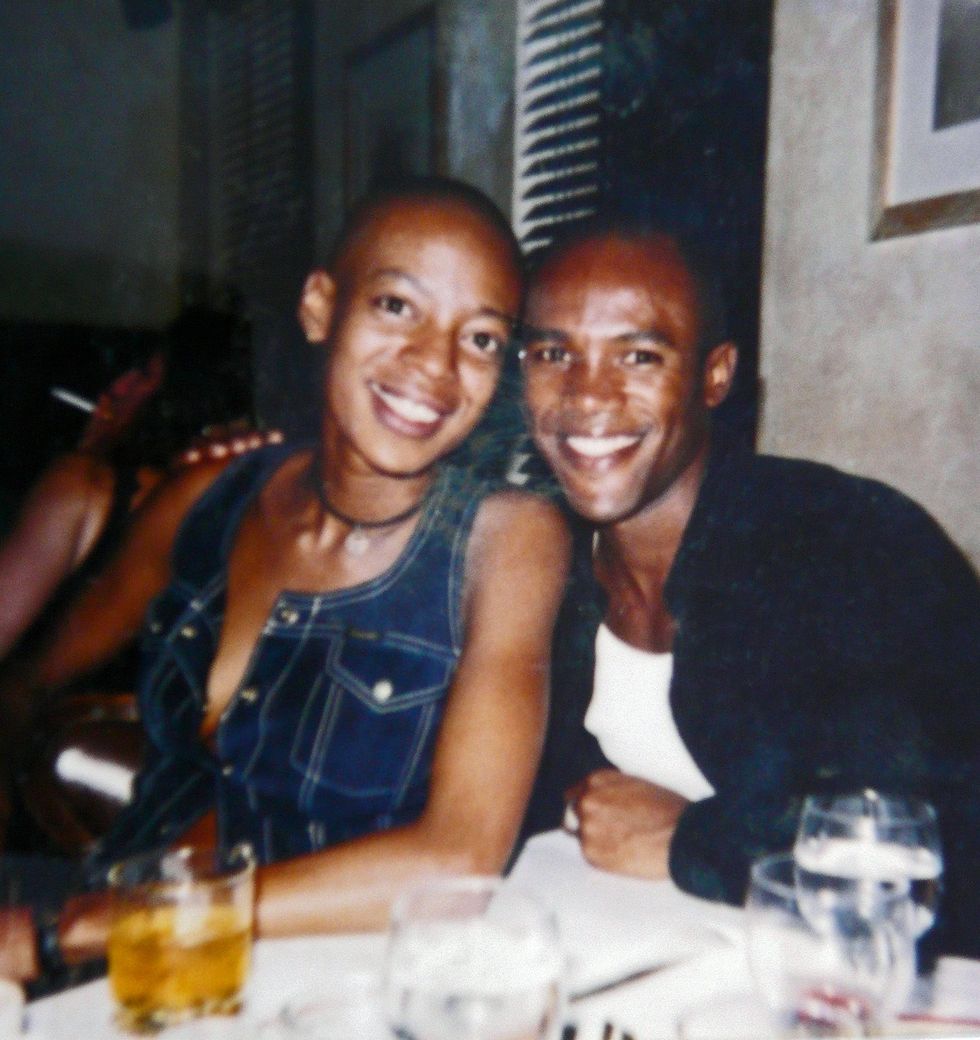
One hundred years ago, lesbians were thriving in their own private artistic circles but still had to maintain a cloak of passing heterosexuality in the interest of their own safety. Every decade following had its own lesbian subcultures (from butch/femme in the 1950s to the respectability politics of the Daughters of Bilitis into the Gay Liberation of the late-'60s), but the proliferation of lesbian visibility that the '70s brought exploded notions of a monolithic sameness when the Sex Wars divided lesbians over things like porn, sex work and S&M into the '80s.
When award-winning writer, publisher and sexpert Susie Bright went to work at the hotly contested lesbian erotic magazine On Our Backs in San Francisco in the '80s, she tells PAPER "being in the closet was still de rigor for lesbians and seemed to be just the province of a few well-placed gay men."
Facing "real denigration exclusion and persecution by the conservative mainstream feminist movement," Bright and the sex workers who both posed for and published On Our Backs were told they were ruining the progress feminists had made by celebrating their bodies, their desires and their sex positivity in editorial spreads and articles as their answer to Playboy (they even had a butch pin-up of the month).On Our Backs published from 1984 to 2006, long outlasting lesbian chic's 15 minutes, which Bright credits "not just because of our sex appeal but because the charisma and the political vision of 'what if women's sexuality had nothing to do with virtue or decoration or her fertility?'"
"We strutted our stuff and we voiced our political point of view, and then years later in the nineties, this lesbian chic thing comes splashing across the mainstream press, and my first reaction was, without us, this wouldn't have happened, but I already hate it because it is a new kind of packaging of titillation for men and an accentuation of the femme to the exclusion of the butch," Bright said. (Radical Desire, a retrospective of On Our Backs and its historic women and trans photographers is available virtually from Cornell.)Part of the problem was not just that the idea of lesbians being cool for a moment was not just that it commodified lesbians as a consumable lifestyle, but it suggested lesbianism was something to put on temporarily, like a costume for a theme party.
"Lesbian sexual power is not because you're skinny or petite or rich or have the perfect complexion or have a Gucci bag or friends in high places. It's not about 'Ha ha, I was a lesbian at a party for five minutes — it was incredible!'" She adds wryly: "If it stops them from killing us and taking our children and refusing to hire us and chasing us out of our homes and refusing to let us attend our family death beds — if that's what this is about, great, have your little lesbian chic moment."
The reality of representation was not all positive: 1993 was the first year hate crimes against gays surpassed racially motivated attacks. The '90s in particular were record-breaking for lesbian murders — Talana Kreeger in 1990, Susan Pittmann and Christine Puckett in 1992, Sylvia Lugo in 1995, Roxanne Ellis and Michelle Abdill in 1995, Julie Williams and Lollie Winans in 1996 and Martha Oleman in 1997. Although not a lesbian, trans man Brandon Teena's murder also sent reverberations through the community.
Simply seeing more depictions of gay women wasn't necessarily translating into acceptance or a promise of safety. In fact, it seemed being more visible made them more of a target, which has always been a conundrum for gender-nonconforming people. A media-sanctioned celebration of cisgender, able-bodied, middle-to-upper-class lesbians wasn't helpful to all lesbians, which begs the continual question: If that's the case, how could "lesbian chic" be good at all? What started as a celebration of k.d. lang as a masc-of-center cover model from Alberta, Canada was swiftly reconfigured into a fashion moment that inevitably leaned away from female masculinity and into the edgy but non-threatening "lipstick lesbian."
Today, there seems to be a discrepancy on what lesbian chic is – A look? A red lip? A swagger? An identity? – and that adds to the confusion. Fashion expert Chelsea Fairless, co-creator of the popular Instagram account and podcast Every Outfit on Sex and the City, defines lesbian chic as a style that women have always and still wear today.
"It was kind of like the '90s version of Marlene Dietrich," Fairless tells PAPER. "It was about the men's wear, but with full lipstick heels, in many instances, gelled hair."
Fairless designed a T-shirt for (ex-girlfriend) butch comic-actor and Tabac regular Lea DeLaria that bemoaned the moment that she sold at public appearances, reading: "I survived lesbian chic," with 'lesbian chic' written in red lipstick.
"Lea is a butch woman of a certain age, and that shirt is speaking to her fans that had a similar experience or a similar reaction to lesbian chic at the time that it was happening," Fairless said. She points to an OUT cover DeLaria shot in 1998 that DeLaria posted for a throwback Thursday not long ago, with DeLaria writing in the caption, "Why the fuck am I wearing lipstick? And grabbing my tit?!" That it was a gay magazine and six years after lesbian chic was au courant suggested that something had been lost in translation.
DeLaria was not the lone butch at Tabac, and Nash is quick to point out that the party was not solely catering to high-femme fashion models and their famous friends.
"There were celebrities in there, but we had friends who were construction workers who build skyscrapers. I think those women are equally badass," Nash says. "There we had school teachers, professors. We wanted to make it women from all walks of life. It wasn't just exclusive to just pretty models."
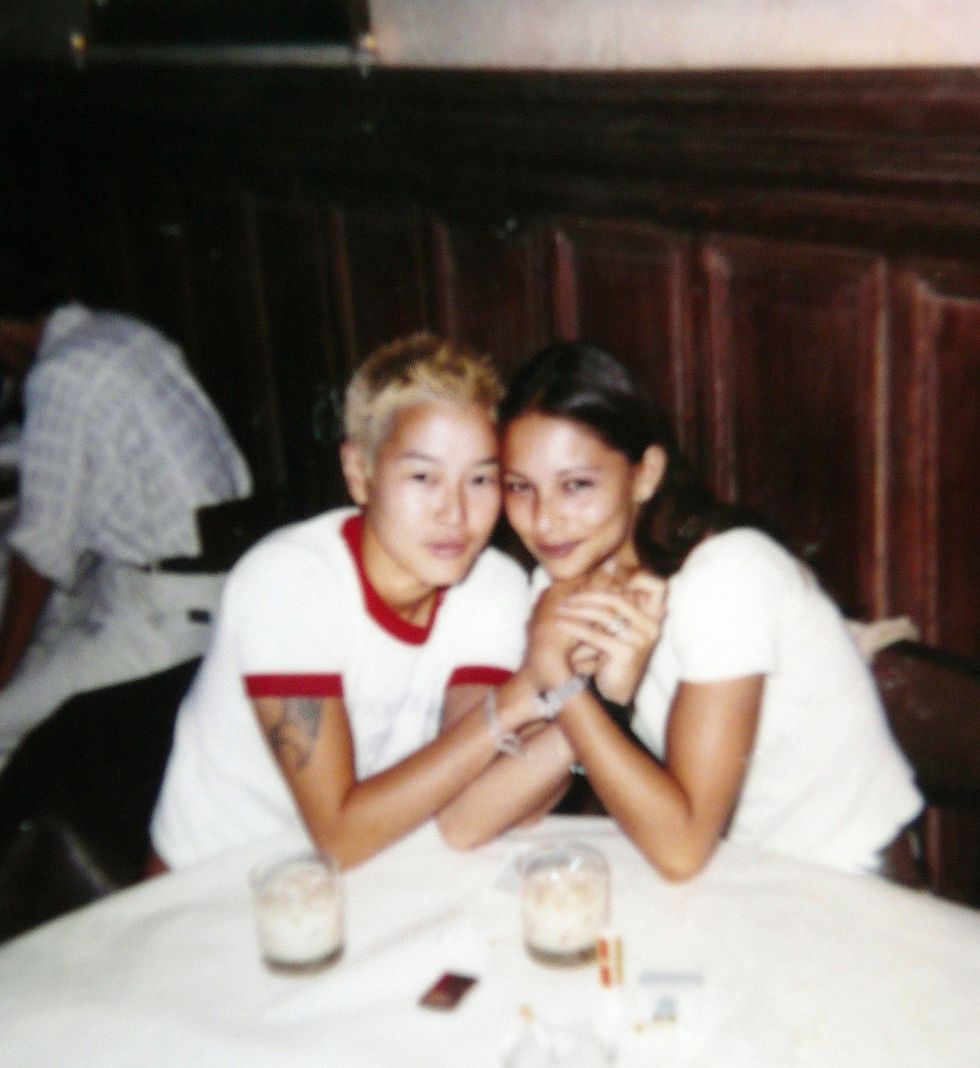
Nationally, the publicity offered helped to establish lesbians as a demographic to be counted and catered to, but in many ways clung to the preferred idea of an acceptable type of lesbian. (DeLaria, for one, played a lecherous butch coming onto Goldie Hawn in the 1996 film "The First Wives Club" in an otherwise comical scene at a hip lesbian bar. She's played several more stereotypical roles of the same ilk since.) But there's no question Ellen DeGeneres couldn't have come out on primetime television without kd lang and, arguably, lesbian chic having given networks enough proof that there could be a monetary benefit from teasing something so taboo. (Lang, of course, appeared in the episode.)
The best-selling musical tour of the late-'90s, the all-women's Lilith Fair, had what Sullivan can attest to from personal experience, "lesbian feminist aesthetics." It's when the 'chic' replaces feminism that things get cloudy.
"As the mainstream media picks up and tries to narrate lesbian chic, it has this way of basically being like 'Don't worry, lesbians aren't as threatening as they seem because they're like all just good girls!'" Sullivan says.
"Before there was lesbian chic there was lesbian invisibility," Bright said in a 1997 interview. "I'd rather be visible. I know how much I felt like I suffered when the media only discussed the gay community in terms of gay men. But lesbian chic is just another signal of exploitation, like when feminists were portrayed only as bra-burners."
New York Magazine, the very publication that had deemed lesbians chic in the first place, declared it past its expiration date by 1995 in a piece about Sundays at Café Tabac. Things were coming to an end. The piece quoted a "sardonic regular" quipping, "There's nothing to do but gawk at all the beautiful people."In 1995, lang's Ingenue follow-up All You Can Eat didn't replicate the former's success, and Madonna was looking to soften her image with her post-Erotica album, Bedtime Stories, and seemed to have tired of lesbians as an accessory. Tabac had become so big that Acosta and Nash (ex-girlfriends) had both floors and lines out the door on four-day weekends. The venue's vibe was changing, following the new New York City trend for lounges, thrift store couches replacing tables and doing away with dinner altogether.
"It totally changed the space," Acosta said. "It totally changed the party."
Nash said she knew that Sundays at Café Tabac were over when one night, Kate Moss came up the steps, followed by Johnny Depp instead of a gang of supermodels.
"People were like 'Johnny Depp is here,'" Nash recalls. "I'm like 'Yeah, pretty much a wrap for us. It's over.'"
Nash and Acosta both went on to throw other successful parties, but their Sundays at Café Tabac have remained a particularly positive experience for many women who found it a place to see and be seen. Nothing has resonated quite like those nights of lesbian du jour. The struggle now is, like most independent lesbian efforts, the documentary about Sundays is underfunded and the filmmakers are looking for support to bring the project to fruition. (Donations can be made directly to Café Tabac on their website.)
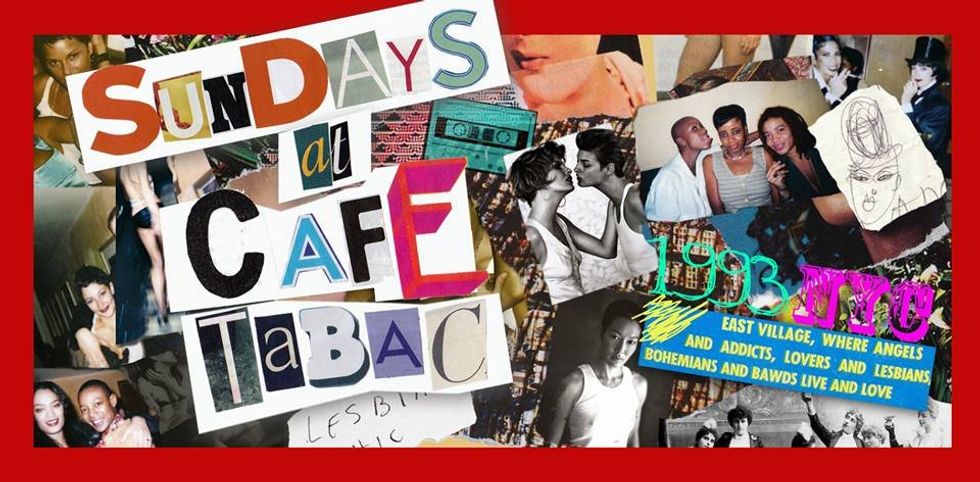
Lesbians continue to have their chic fashion moments – brands like The Row, Celine and Louis Vuitton have borrowed from OGs like openly lesbian designer Jil Sander, putting models in boxy baggy suits. "Dressing like a lesbian" is still in or out depending largely on what celebrities are wearing anything akin to menswear. Without stylist Patricia Field, Sex and the City would not have been the fashion inspiration that it was, with every single character on the show having lesbian chic moments of their own. (Fairless points to the 1997 episode where Charlotte befriends a group of art world power lesbians who want her to commit, not just play the part. When Charlotte says she loves female energy but prefers men, one power lesbian tells her, "Sweetheart, that's all very nice. But if you're not going to eat pussy, you're not a dyke.") Without the success of Sex and the City, there wouldn't be The L Word, a show that was essentially lesbian chic in aspiration and action. (Its new iteration Generation Q is as much a reaction to the original as lesbian chic was to second-wave lesbians of the '70s.)
Nowadays, Brandi Carlile struts in k.d. lang's heeled boots and designer and creative director Jenna Lyons is joining Martina Navritova's wife as an openly gay Real Housewife as she joins the New York cast this coming season. Some of the most famous and well-regarded lesbians are anchoring Good Morning America, hosting the Oscars and being named "Couture Week's Best Dressed Couple" by Vogue. Lesbian bars may be in flux, but queer nightlife and the intentional creation of inclusive spaces is consistently evolving. And despite clickbait proclamations that 30 years after being chic, lesbians are so over, that's just not the reality. Are lesbians ever really done processing?
Sullivan says a lot of the conversations happening at the time of lesbian chic in lesbian and queer communities but also nationally are very mirrored right now.
"There are attempts from mainstream media to soften 'lesbian,'" Sullivan says, "but I actually think that the response from the lesbian community was a very strong engagement with lesbian politics and dyke politics – and I think we see that coming back in full force right now."
Just like Madonna.
Photos courtesy of Wanda Acosta and Karen Song
From Your Site Articles
Related Articles Around the Web